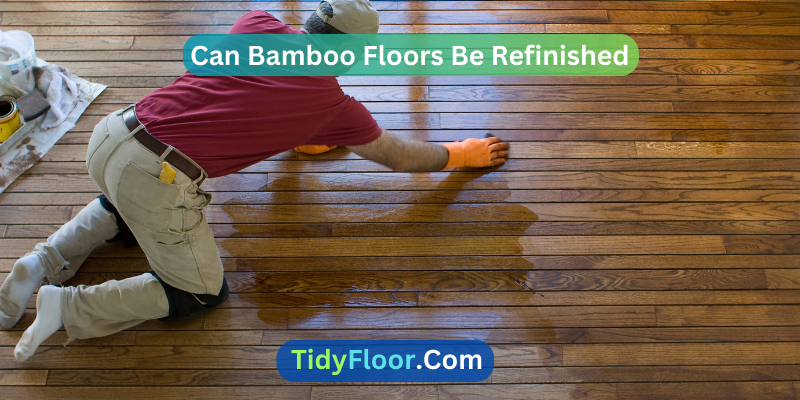Bamboo flooring has gained significant popularity in recent years due to its eco-friendliness, durability, and unique aesthetic appeal. However, like any other flooring material, bamboo floors can show signs of wear and tear over time. This often leads homeowners to wonder: Can bamboo floors be refinished? The answer is yes, but the process is slightly different from refinishing hardwood floors.
For bamboo flooring to be refinished, it is necessary to assess its condition, sand gently, optional staining, apply a water-based polyurethane finish, polish, and allow ample curing time for a renewed and enduring elegant appearance.
In this article, we will guide you through the step-by-step process of refinishing bamboo floors, ensuring that you can make an informed decision about rejuvenating your bamboo flooring.
6 Step-by-Step Process of Refinishing Bamboo Floors: Easy Method
For bamboo flooring to be refinished, you need to be quite cautious and know the right procedure. Without following the right process, you may end up damaging the floor. Here are the steps for refinishing bamboo flooring in the simplest possible way.
1. Assessment and Preparation:
Before diving into the refinishing process, it’s crucial to assess the condition of your bamboo floors. Check for any deep scratches, dents, or water damage that might require special attention. Ensure the floor is clean and free from any debris. Remove all furniture and rugs from the area.
2. Sanding:
Sanding is a crucial step in refinishing bamboo floors. However, bamboo flooring is softer than hardwood, so it’s essential to use a gentle touch. Begin with a fine-grit sandpaper and gradually progress to coarser grits if necessary. Make sure to sand evenly to avoid creating uneven surfaces.
3. Staining (Optional):
Staining can add a new dimension to your bamboo floors by changing their color. If you wish to change the color of your bamboo flooring, choose a high-quality bamboo-compatible stain. Test the stain on a small, inconspicuous area before applying it to the entire floor to ensure you achieve the desired shade.
4. Sealing:
After sanding and staining (if applicable), it’s time to apply a protective finish to your bamboo floors. Opt for a water-based polyurethane finish, as oil-based finishes can yellow over time and alter the natural beauty of the bamboo. Apply thin coats of the finish, allowing each coat to dry completely before applying the next. Sand lightly between coats for a smooth finish.
5. Buffing and Polishing:
Once the final coat of finish has dried, use a buffer or a soft cloth to polish the floor gently. This step will help smooth out any minor imperfections and enhance the shine of your newly refinished bamboo floors.
6. Curing Time:
It’s essential to allow ample time for the finish to cure properly. This can typically take a few days to a week, depending on the manufacturer’s recommendations. During this time, avoid placing heavy furniture or rugs on the floor to prevent any potential damage.
10 Tips About Refinishing Bamboo Hardwood Floors: For The Best Result
Refinishing bamboo hardwood floors can breathe new life into your living space, but it’s crucial to approach the process with care and consideration. Bamboo floors offer a unique charm, and while they can be refinished, there are some essential tips to keep in mind to achieve the best results.
1. Choose the Right Time:
Timing is essential when refinishing bamboo floors. Opt for a time when you can keep the room well-ventilated to ensure proper drying of the finish. This might mean choosing a season with mild weather to allow windows to be open for fresh air circulation.
2. Assess the Thickness:
Bamboo floors come in different thicknesses. Thicker planks can withstand multiple refinishing rounds, while thinner ones might have limited refinishing potential. Check the manufacturer’s recommendations and consult a professional if unsure about the thickness of your bamboo flooring.
3. Gentle Sanding Technique:
Due to bamboo’s softer nature compared to hardwood, employ a gentle sanding technique. Start with fine-grit sandpaper and avoid excessive pressure. Gradually progress to coarser grits if needed, maintaining a light touch to prevent over-sanding.
4. Staining Considerations:
Deciding to stain bamboo floors during refinishing requires careful consideration. While staining can offer a fresh look, it’s essential to choose a bamboo-compatible stain and test it on a small area first. Bamboo’s unique grain can react differently to stains, so testing is crucial to achieving the desired color.
5. Opt for Water-Based Finishes:
When selecting a finish, opt for water-based polyurethane. Unlike oil-based finishes that can yellow over time, water-based options retain the bamboo’s natural hue. Apply thin coats, allowing ample drying time between each layer.
6. Thorough Cleaning:
Before applying the finish, ensure the bamboo floor is thoroughly cleaned. Any dirt, dust, or debris can affect the quality of the finish. Use a gentle cleaner suitable for bamboo and allow the floor to dry completely before proceeding.
7. Patience During Curing:
The curing process is critical to the durability of the refinished bamboo floors. Exercise patience and avoid placing heavy furniture or rugs on the floor for the recommended curing duration. This prevents premature damage and ensures the finish sets properly.
8. Regular Maintenance:
After refinishing, commit to regular maintenance to extend the lifespan of your bamboo floors. Use soft bristle brooms and microfiber mops for cleaning, and avoid harsh chemicals that can damage the finish.
9. Professional Consultation:
If you’re uncertain about any aspect of refinishing bamboo floors, it’s wise to seek professional consultation. Flooring experts can offer tailored advice based on your specific flooring type and condition.
10. Longevity and Enjoyment:
By following these tips, you can successfully refinish your bamboo hardwood floors and enjoy their beauty and durability for years to come. The careful approach you take during the refinishing process will pay off in the form of a refreshed living space that exudes elegance and charm.
10 Mistakes to Avoid When Refinishing Engineered Bamboo Floors:
Refinishing engineered bamboo floors can be a great way to enhance their appearance and extend their lifespan. However, this process requires careful attention and a keen understanding of the material’s unique characteristics. To ensure a successful refinishing project, here are some common mistakes to avoid:
1. Neglecting Thickness Constraints:
Engineered bamboo floors consist of a thin layer of bamboo over a plywood or composite core. This means they have a limited thickness, making them less suitable for repeated refinishing. Neglecting this constraint and attempting multiple refinishing rounds can damage the thin bamboo layer.
2. Overaggressive Sanding:
Engineered bamboo’s thin top layer is sensitive to aggressive sanding. Using heavy-grit sandpaper or applying excessive pressure can lead to irreparable damage. Opt for gentle sanding techniques with finer grits to prevent wearing down the bamboo layer too quickly.
3. Skipping Patch Tests:
Not all engineered bamboo floors react the same way to stains and finishes. Skipping patch tests before applying stain can result in uneven coloration. Test the stain on an inconspicuous area to ensure it achieves the desired hue before proceeding.
4. Choosing the Wrong Finish:
Selecting an inappropriate finish can lead to poor results. Avoid oil-based finishes that might not adhere well to engineered bamboo. Instead, opt for water-based polyurethane finishes designed for bamboo floors to maintain their natural appearance and durability.
5. Rushing the Drying Process:
Rushing through the drying process between coats of finish can compromise the final result. Allow each coat to dry fully as per the manufacturer’s recommendations before applying the next. This prevents unevenness, bubbling, or an incomplete seal.
6. Skipping Proper Cleaning:
Refinishing requires a clean surface to achieve a flawless finish. Neglecting thorough cleaning before starting can lead to debris and particles becoming trapped in the finish, affecting the appearance and texture of the floor.
7. Ignoring Curing Time:
The curing process is essential for the finish to harden and adhere properly. Avoid placing heavy furniture or rugs on the floor before the recommended curing time has passed. This prevents premature damage to the newly refinished surface.
8. DIY Mistakes:
While refinishing can be a DIY project, lack of experience can lead to errors. Complex issues like uneven sanding, incorrect application of finishes, or inadequate ventilation can compromise the final outcome. When in doubt, consult professionals for advice or hire experts for the job.
9. Failing to Maintain Regularly:
Refinished engineered bamboo floors require ongoing care to maintain their beauty. Skipping routine cleaning, using harsh chemicals, or neglecting to put protective pads under furniture legs can lead to premature wear and the need for more frequent refinishing.
10. Not Seeking Professional Help:
If you’re uncertain about any aspect of refinishing engineered bamboo floors, seeking professional help is a wise choice. Flooring experts can provide tailored advice based on the specific type of engineered bamboo you have, ensuring a successful refinishing process and a stunning end result.
FAQs:
Can Bamboo Floors Be Refinished?
Yes, bamboo floors can be refinished to restore their original beauty. The process involves sanding, staining (optional), applying a protective finish, and polishing.
How Do I Assess The Condition Of My Bamboo Floors?
Examine for deep scratches, dents, or water damage. Clean the floor thoroughly and remove furniture and rugs to get a clear view of the condition.
Can I Use Regular Sandpaper For Sanding Bamboo Floors?
It’s recommended to use a fine-grit sandpaper specifically designed for bamboo to prevent over-sanding, as bamboo is softer than hardwood.
Is Staining Bamboo Floors Necessary After Sanding?
Staining is optional but can provide a fresh look. Test the stain on a small area first to ensure the desired color, then apply evenly.
What Kind Of Finish Should I Use To Refinish Bamboo Floor?
Choose a water-based polyurethane finish as it won’t yellow over time and is suitable for bamboo floors. Apply thin coats, allowing each to dry completely.
How Do I Ensure A Smooth Finish?
Sand lightly between each coat of finish using fine-grit sandpaper to achieve a smooth and even surface.
Can I Walk On The Floor Immediately After Refinishing?
It’s advisable to avoid walking on the floor for at least 24 hours after applying the final coat of finish to prevent any damage.
How Long Does The Curing Process Take After Refinishing?
The curing process typically takes a few days to a week, during which you should avoid placing heavy furniture or rugs on the floor to allow the finish to set properly.
Can I Refinish Bamboo Floors On My Own?
Yes, you can refinish bamboo floors as a DIY project, but it requires careful attention to detail. If unsure, consulting a professional is recommended.
How Often Should Bamboo Floors Be Refinished?
Bamboo floors can be refinished every 5-7 years, depending on the wear and tear they experience. Regular cleaning and maintenance can help prolong the time between refinishing sessions.
Conclusion:
Refinishing bamboo floors is a viable option for restoring their beauty and extending their lifespan. While the process shares some similarities with refinishing hardwood floors, it requires a more delicate approach due to the bamboo’s softer nature.
Just remember, if you’re not confident in your DIY skills, it’s always a good idea to consult a professional flooring expert to ensure the best results.


